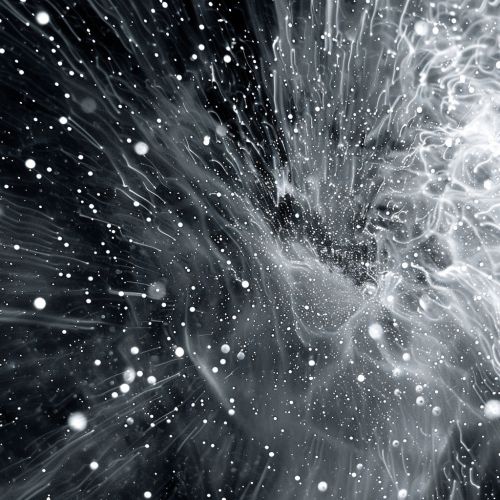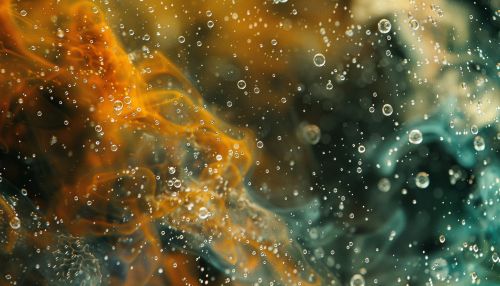Gas
Introduction
A gas is one of the four fundamental states of matter (the others being solid, liquid, and plasma). A pure gas may be made up of individual atoms (e.g. a noble gas like neon), elemental molecules made from one type of atom (e.g. oxygen), or compound molecules made from a variety of atoms (e.g. carbon dioxide). A gas mixture, such as air, contains a variety of pure gases. What distinguishes a gas from liquids and solids is the vast separation of the individual gas particles. This separation usually makes a colorless gas invisible to the human observer. The interaction of gas particles in the presence of electric and gravitational fields are considered negligible, as indicated by the constant velocity vectors in the image. One type of commonly known gas is natural gas.


Properties of Gases
Gases have four properties which can be observed with our senses: they have mass, they take up space (have volume), they can be compressed, and they fill their containers. Unlike solids and liquids, gases are compressible. This is because most of the volume occupied by a gas is empty space. The molecules of a gas are moving in constant, random motion and consequently have kinetic energy. This kinetic energy is a measure of the temperature of the gas.
Mass
Although we can't see gases, we can demonstrate that they have mass. This property is the same as the property of solids and liquids and is a basic property of matter. You can prove that gases have mass by weighing a basketball before and after you inflate it. The inflated basketball weighs more because of the added mass of the gas inside the basketball.
Volume
Gases have a definite volume but not a definite shape. They take on the shape of whatever container they are in. If you blow up a balloon, it will take the shape of the balloon. The gas fills the balloon and takes its shape.
Compressibility
Gases can be compressed much more than liquids or solids. This is because there is a large amount of space between particles in a gas. The particles can move closer together when pressure is applied.
Filling a Container
Gases will fill any container they are put into. If you open a bottle of perfume, the smell spreads throughout the entire room. This is because the gas particles move constantly and rapidly and eventually spread evenly throughout the room.
Behavior of Gases
Gases all have the same properties, and gases are all affected equally by temperature, pressure, volume, and the number of gas molecules. The relationship between these properties determines how a gas behaves. These relationships are described by the gas laws.
Gas Laws
The gas laws consist of three primary laws: Charles' Law, Boyle's Law and Avogadro's Law, and they describe how gases behave. The gas laws were developed at the end of the 18th century, when scientists began to realize that relationships between pressure, volume and temperature of a sample of gas could be obtained which would hold to approximation for all gases.
Charles' Law
Charles' Law, named after French scientist Jacques Charles, describes how gases tend to expand when heated. It states that, for a given mass of gas at constant pressure, the volume is directly proportional to its absolute temperature.
Boyle's Law
Boyle's Law, named after Robert Boyle, describes how the pressure of a gas tends to decrease as the volume of a gas increases. It states that the pressure and volume of a gas have an inverse relationship when temperature is held constant.
Avogadro's Law
Avogadro's Law, named after scientist Amedeo Avogadro, states that equal volumes of gases at the same temperature and pressure contain the same number of molecules regardless of their chemical nature and physical properties.
Types of Gases
There are many different types of gases. Some of these are natural gases like methane and carbon dioxide, and others are man-made like chlorofluorocarbons (CFCs). Each of these gases has different properties and uses.
Natural Gases
Natural gases are found in the earth's atmosphere and are usually non-toxic and non-reactive. Some examples of natural gases include nitrogen, oxygen, argon, neon, and helium.
Man-Made Gases
Man-made gases are created by humans for specific purposes. Some examples of man-made gases include chlorofluorocarbons (CFCs), which are used in refrigeration and aerosol propellants, and sulfur hexafluoride, which is used in the electricity industry as an insulating gas for high voltage equipment.
Uses of Gases
Gases have a wide range of uses. They can be used for heating, in the production of electricity, in cooking, as a refrigerant, and in welding.
Heating
Natural gas is used in homes and businesses for heating. It is a clean, efficient, and economical source of energy.
Electricity Production
Natural gas is also used in the production of electricity. It is burned in a gas turbine or steam generator to produce electricity.
Cooking
Natural gas is used in cooking, both in homes and in commercial establishments. It provides a controllable and efficient heat source.
Refrigeration
Gases such as ammonia and carbon dioxide are used in refrigeration systems. These gases can be compressed and then allowed to expand, which causes them to cool.
Welding
Gases such as acetylene and oxygen are used in welding. The gases are burned to produce a high temperature flame that can melt metal.
Environmental Impact of Gases
While gases have many useful applications, they can also have negative impacts on the environment. Some gases, such as carbon dioxide and methane, are greenhouse gases that contribute to global warming. Other gases, such as chlorofluorocarbons (CFCs), can deplete the ozone layer.
Greenhouse Gases
Greenhouse gases trap heat in the earth's atmosphere, leading to global warming. The primary greenhouse gases are carbon dioxide, methane, nitrous oxide, and fluorinated gases.
Ozone Depletion
Chlorofluorocarbons (CFCs) are man-made gases that can deplete the ozone layer. When CFCs are released into the atmosphere, they can rise to the stratosphere, where they are broken apart by solar radiation, releasing chlorine atoms that can catalyze the destruction of ozone.
